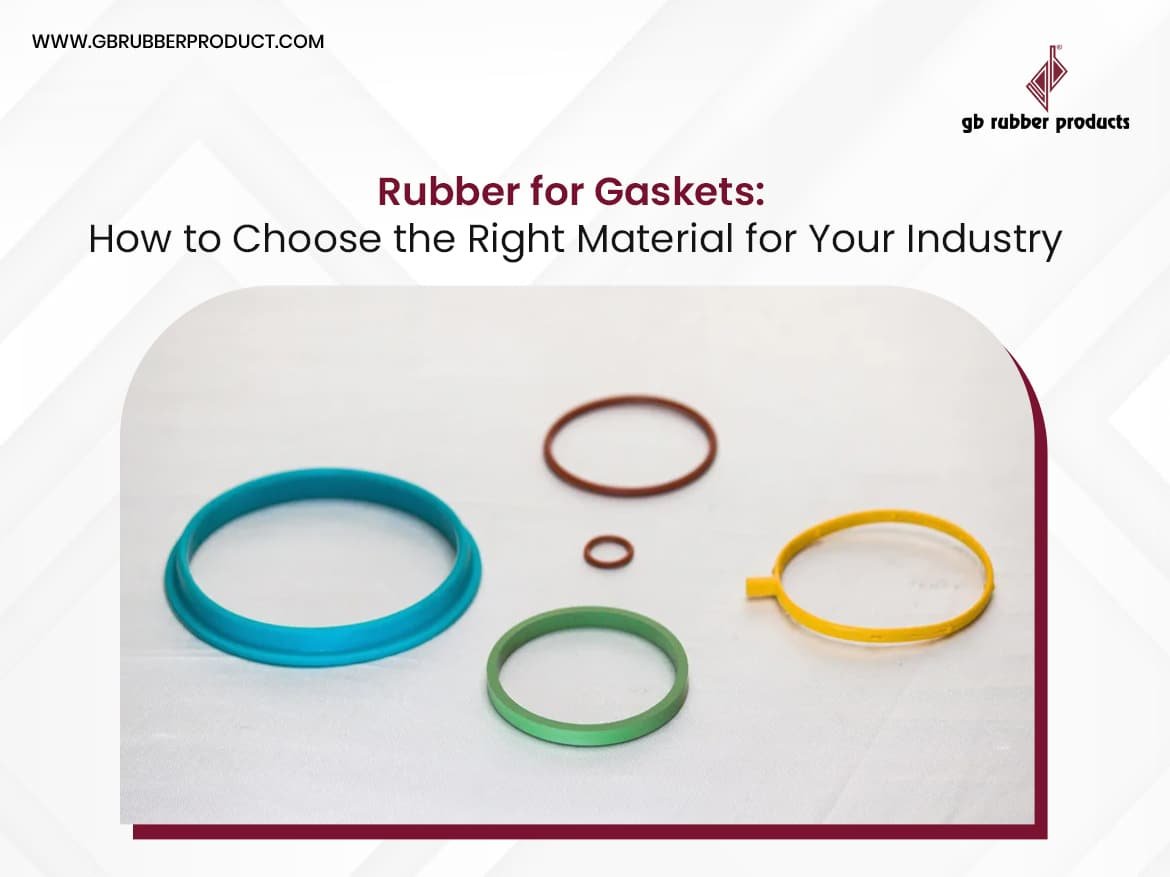When it comes to sealing systems, the smallest component can make or break the whole operation. Gaskets are one of those unsung heroes that keep everything flowing, contained, and efficient. And yet, picking the right rubber for gaskets can feel like walking through a minefield of acronyms, properties, and specifications.
Engineers, OEMs, maintenance heads and procurement professionals all struggle with the same question: Which rubber material do I use for my gasket, and why?
That’s what we’re discussing today. In this blog, we’ll break down what a gasket really does, walk you through key rubber types, and help you decide what suits your specific needs best. Let’s get to the sealing truth.

What Is a Gasket and Why Does Rubber Matter?
At its core, a gasket is a mechanical seal. It fills the gap between two surfaces, typically to prevent leaks or contamination in systems handling fluids, gases and even solids. For a gasket to perform consistently, it must resist compression, temperature changes, chemicals, and vibration.
But here’s the thing: not all gaskets are made equal, and neither are all rubbers. Choosing the wrong rubber material can result in swelling, brittleness, early degradation, or complete failure under pressure.
Each type of rubber comes with its own chemical resistance, temperature range, and mechanical properties. Your decision should be influenced by:
- Operating temperature
- Fluid or gas exposure
- Pressure cycles
- Environmental conditions (UV, ozone, steam)
- Regulatory requirements (FDA, RoHS, etc.)
That’s why the type of rubber for gaskets matters so much because the chemical and physical properties of the rubber directly impact system safety, longevity and cost-efficiency.
Different Rubber Types for Gaskets (and When to Use Them)
Each application demands a specific set of rubber characteristics, chemical resistance, temperature tolerance, flexibility, and durability.
Below is a look at the most common types used in rubber parts manufacturing, with pros, cons, and ideal use cases.
1. Neoprene Rubber
A solid all-rounder. Neoprene stands up to weather, ozone, oil, and moderate chemicals.
- Temp range: -40°C to +120°C
- Best for: Outdoor enclosures, HVAC systems, refrigeration
- Why it works: Flexibility + moderate chemical resistance = reliable sealing
2. Nitrile (Buna-N)
A favourite in fuel and oil industries, thanks to its excellent resistance to petroleum-based fluids.
- Temp range: -40°C to +100°C
- Best for: Automotive, hydraulics, fuel tanks
- Pro tip: Ideal when you’re dealing with lubricants or fuel exposure
3. EPDM Rubber
Known for steam and water resistance, EPDM thrives in outdoor and high-moisture environments.
- Temp range: -50°C to +150°C
- Best for: Solar panels, water treatment, building gaskets
- Bonus: It’s also UV and ozone resistant
4. Silicone Rubber
Extremely temperature resistant and FDA-friendly. The go-to for sensitive applications.
- Temp range: -60°C to +250°C
- Best for: Medical devices, food processing, electronics
- Use case: When purity, sterility, or high heat is a concern
5. Viton® (Fluoroelastomer)
This one’s built for the harsh stuff—strong acids, fuels, solvents, and heat.
- Temp range: -20°C to +230°C
- Best for: Aerospace, chemical plants, refineries
- Pro tip: If you’re sealing volatile compounds, this is your ally
6. Butyl Rubber
Low gas permeability and excellent resistance to moisture make Butyl ideal for airtight seals.
- Temp range: -50°C to +120°C
- Best for: HVAC, pharmaceuticals, dampers
- Fun fact: Also offers great shock absorption
7. Natural Rubber (Gum Rubber)
High flexibility and tensile strength but not suitable for oil or fuel exposure.
- Temp range: -50°C to +80°C
- Best for: Shock-absorbing applications, gaskets in mild environments
- Caution: Avoid use with hydrocarbons
8. SBR (Styrene Butadiene Rubber)
Economical and commonly known as red rubber. Works well in low-pressure systems.
- Temp range: -45°C to +85°C
- Best for: Plumbing, pipe flanges, general water sealing
- Note: Avoid for oil-based or high-heat systems
Why Partnering with the Right Manufacturers Matters
When it comes to industrial sealing, shortcuts are costly. It’s not just about picking rubber; it’s about getting the right grade, thickness, density, and formulation.
This is where experienced rubber parts manufacturing specialists and gaskets manufacturers in India can help. They understand real-world application challenges from oil rig gaskets that battle the sea, to medical seals that need sterile perfection.,
You get expertise, customization, and reliability in one place.
Choose Performance, Not Just Price
In sealing systems, compromise is a risk you can’t afford. The right rubber for gaskets will not only extend equipment life but also reduce downtime, maintenance costs, and leakage risks.
This is where experienced rubber parts manufacturing specialists and gaskets manufacturers in India can help. They understand real-world application challenges, from oil rig gaskets that battle the sea to medical seals that need sterile perfection.
So, before you settle for what’s “in stock,” talk to seasoned gaskets manufacturers in India who specialize in rubber parts manufacturing for high-stakes industries.
Read More –Everything You Need to Know About Gasket Rubber in One Guide
Looking for a Reliable Rubber Gasket Supplier?
At GB Rubber, we specialize in delivering high-performance rubber gaskets tailored to your exact requirements. From FDA-grade silicone to high-temp Viton, we manufacture custom sealing solutions for industries across the board.
Ready to seal the deal? Let’s build something leak-proof. Request a Quote.



